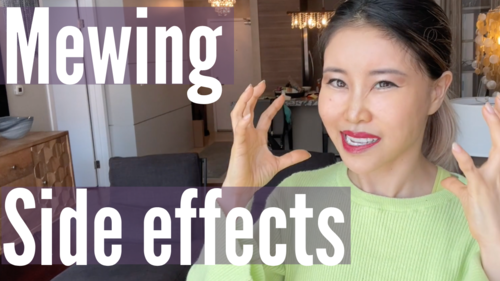Mewing refers to the correct tongue posture that you are supposed to maintain all the time. It has several benefits for both health and beauty. However, the incorrect practice of mewing can lead to side effects. Even if you are doing it correctly, there may still be some symptoms that you could experience, that you'd like to discuss. So, let's dive into this topic and learn more about it.
1. Too much saliva
I noticed that people doing mewing were concerned about producing too much saliva, but I didn't think much of it because saliva is good for your teeth. However, a friend of mine who has been naturally mewing since childhood also experienced excessive saliva and went to the dentist for it. The dentist said that saliva is a good thing, but it got me thinking about the issue. I sometimes feel like I'm swallowing a lot of saliva before bed, but I try not to dwell on it. Hard swallowing every time you swallow your saliva can cause tension in your neck and shoulders and may even lead to sagging skin. Instead, try doing a soft swallow where you use minimal muscle movement. If you feel like you have too much saliva, give it a try. Also, please sign the petition to help save Dr. Mew's dental license.
2. Mallampati score
I learned from Dr. Afzali that mewing can affect something called the Mallampati score, which measures the visibility of the uvula in your mouth when you open it. Mine was a level three, which is not good because it means there's some obstruction to my airway. I realized that I've been too focused on pushing my tongue up and not enough on bringing it down. It's important to have flexibility and elasticity in your tongue muscles to show your uvula completely when you open your mouth. A higher Mallampati score is linked to sleep apnea, so it's worth checking if you have any issues. Remember to focus on both up and down movements in mewing.
3. Asymmetrical mewing.
Essentially, it's when one side of your tongue has more weight than the other, causing your face to appear asymmetrical. This can be fixed with the correct mewing technique. In summary, there are three possible side effects from mewing excessive saliva, Mallampati score, and asymmetrical mewing. It's important to do mewing correctly to avoid these issues. Remember to practice a soft swallow and not just focus on bringing the tongue up, but also down for a symmetrical face.
Summary:
If you're interested in more exercises, check out our Face Yoga app for a free download and try out our asymmetry face analysis on iPhone (not Android yet). Also, if you want to teach the Koko Face Yoga method, check out our website for the live stream date launch next year. You can choose between an on demand or live-stream version.

